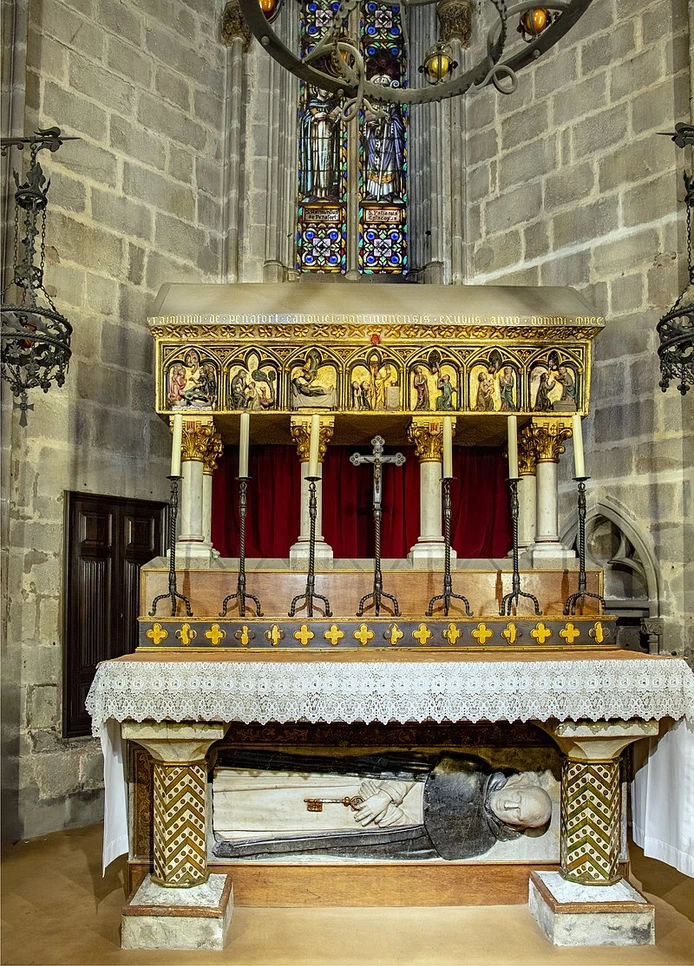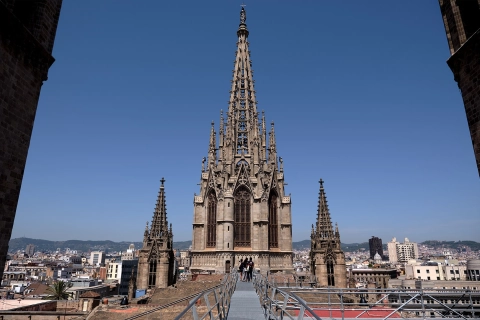After a wonderful spread of Spanish ham and Spanish-style omelets, along with the usual breakfast fare of bread, eggs, fruits, cereal, yogurt, and cold cuts at the hotel’s restaurant, we were ready to start a day of exploration around Barcelona.
The morning’s schedule consisted of a walking tour of the city's old district, the Barri Gotic, and our first stop was the Barcelona Cathedral, also known as The Cathedral of the Holy Cross and Saint Eulalia or La Seu (The Seat or The Headquarters).
The Gothic cathedral is the seat of the Archbishop of Barcelona and is dedicated to a young virgin saint named Eulalia, who suffered martyrdom during the Roman times and is now the patron saint of the city. Her tomb lies buried beneath the main altar inside the church.
Often overshadowed by La Sagrada Familia, the Barcelona Cathedral is, nevertheless, an important landmark in Catalonia. This church stands on the same site as the former Roman Temple, then later transformed into an Arab mosque, and finally into a Romanesque cathedral that evolved over time. Construction began in 1298 and it took 600 years to finish it. Its architecture reflects the different generations of builders and designers who left their imprints in this splendid building.
Today, it stands as the biggest church in Barcelona and one of the most impressive in the whole of Catalonia. Its stunning Gothic façade is beautifully decorated with statues, arches, and pinnacles. Inside, it has a spectacular nave flanked by 28 chapels brightened by exquisite stained-glass windows.
For me, personally, its charm lies in its unique feature not found in most churches - a cool cloister with a Mediterranean garden in the middle, where you will find geese roaming around.
The secluded cloister, built between the 14th and 15th centuries, has a quadrangular floor plan and consist of four galleries with pointed arches separated by columns. Sculpted into the pillars of the arches are scenes from the Old Testament and legends about the Holy Cross, while the keystones depict scenes from the New Testament. In the centre is a courtyard with a fountain surrounded by Mediterranean palms, magnolias, and orange trees. Completing this refreshing garden oasis in the middle of the somber Gothic structure are the honking sounds from the cloister's 13 resident geese.
The white geese are kept to represent Saint Eulalia’s years on earth before her martyrdom. Why geese? Why not swans or ducks or peacocks? While it is believed that the saint used to be a goose herder, the reason behind the choice of symbolism was said to be a more practical one. Since goose sounds are deafening and terribly annoying, their unwanted noise was a good deterrent against potential intruders and thieves.
And if you were to ask me, I would say that it is a wise choice. If you have ever dealt with Canadian geese during the nesting season, you will know what I mean (and for those who do not know, Canadian geese protecting their eggs or their young will hiss at you, or even attack you, if they feel threatened...such feisty fowls those are!). I am guessing European geese are no different.
Our Tour Director pointed at the central spout of the fountain and told us about the annual tradition of L’ou com balla, or the miracle of the egg that is made to "dance" over the water jet on the Feast of Corpus Christi. This dates back to the 17th century and is supposed to symbolize either the Body of Christ, or the circle of life, depending on who you talk to. It would have been nice to witness this, as this is unique to Barcelona, but we were not there at the time of the feast. He also said that casting a coin into the fountain will bring blessings and good luck, so we each dropped a coin and said our prayers.
A statue of San Jordi (St. George), Barcelona’s co-patron saint, can also be found in the courtyard. He is depicted as killing a dragon, the embodiment of evil. The Feast of San Jordi on April 23rd is celebrated in Barcelona in the style of Valentine's Day and is also referred to as the, "Rose and Book Festival." Each year, the streets are filled with people strolling around, grasping books and roses wrapped in ribbons in the colours of the Catalan flag (The Senyera). The basic idea for the celebration is that men give women roses and women give men books. I personally prefer being the recipient of books, instead of roses. Hahaha!
But why roses and books? This curious festival comes from a mixture of traditions from different periods. According to legend, San Jordi saved a princess from a dragon that had been terrorizing their village. After killing the dragon, San Jordi saw red roses, instead of blood, spilling out of the beast's body and he gave them all to the princess. That explains the roses.
As for the books, the custom is from a much more recent history. It began in 1926 when a writer, journalist, and editor prompted this initiative to promote Catalan writing. We were told that April 23rd is the death anniversary of Miguel de Cervantes, best known for his novel, Don Quixote, and is regarded as the greatest writer in the Spanish language. Coincidentally, April 23rd is also the death anniversary of England's William Shakespeare. The best way to commemorate these literary greats is, of course, by celebrating literature.
The cathedral also houses several religious and royal tombs. St. Eulalia’s tomb is enshrined in a spectacular alabaster crypt that has carvings of the events of her martyrdom. They tell the story of how the Romans inflicted 13 agonies on this maiden, one for every year of her life - from imprisoning and beating her, to torturing her on a rack, burning her breasts, and throwing her into a ditch of quicklime, as well as a yard swarming with fleas. The ninth torment is the most famous, whereby she was put naked into a cask filled with broken glass, nails and knives and thrown down a steep street which was thereafter known as the Baixada de Santa Eulàlia. Finally, she was nailed to an x-shaped cross, which today is the emblem of the cathedral.
For a 13-year old girl to endure all that in the name of faith, it must have taken a lot of courage and piety. She was barely in her teens, just crossing that line from childhood. I started to ponder if I were that brave and pious at the same age and if today's teenagers, saturated with social media and technology, and dealing with high social expectations and magnified peer pressure, could measure up to that. Of course, we'd never really know.
The church also contains the tombs of two other saints - St. Olegarius who was the Archbishop of Barcelona and Tarragona in the 10th century, and St. Raymond of Penyarport, a Spanish Dominican friar who lived in the 13th century. Also entombed there are the remains of a count and a countess, and several bishops who had been instrumental in the construction of this church.
Among its numerous chapels, one stands out – The Chapel of the Holy Sacrament and of the Holy Christ of Lepanto. It features a cross that dates back to the Battle of Lepanto in 1571. What is unique about this cross is the curved shape of the body of Christ.
According to Catalan legend, the cross was aboard the ship captained by Juan of Austria, step-brother of Philip II of Spain. During the battle, a cannonball flew towards the cross, but the figure of Christ leaned out of the way to avoid being hit and it has been inclined ever since. Another version of the legend says that the cross was in the ship’s hold and that the figure moved to cover a large hole that would have sunk the ship.
The cathedral also has a museum in the former Chapter House, which was also used as a soup kitchen in the olden days. It now displays valuable works of art and liturgical objects. Some of them are still used today, such as the gold monstrance which is brought out during the festival of Corpus Christi.
We were told that there is a lift that takes you to the cathedral’s roof, where one could get a bird’s eye view of Barcelona’s Gothic quarter and its skyline, but we didn’t have the time (and one of my travel amigas is afraid of heights). We just stepped outside and from afar, stared at its majestic bell tower. We also walked around the cathedral walls, and admired the striking roof adorned with mythical gargoyles. We bid them goodbye as we set off to see the rest of Barcelona.
Photo Credits:
myculturetrip.com, Bernard Gagnon (Wikipedia), Didier Descouens (Wikipedia), OscarV055 (Wikipedia), barcelonacathedral-tickets.com, barcelona.de,
















































Comments